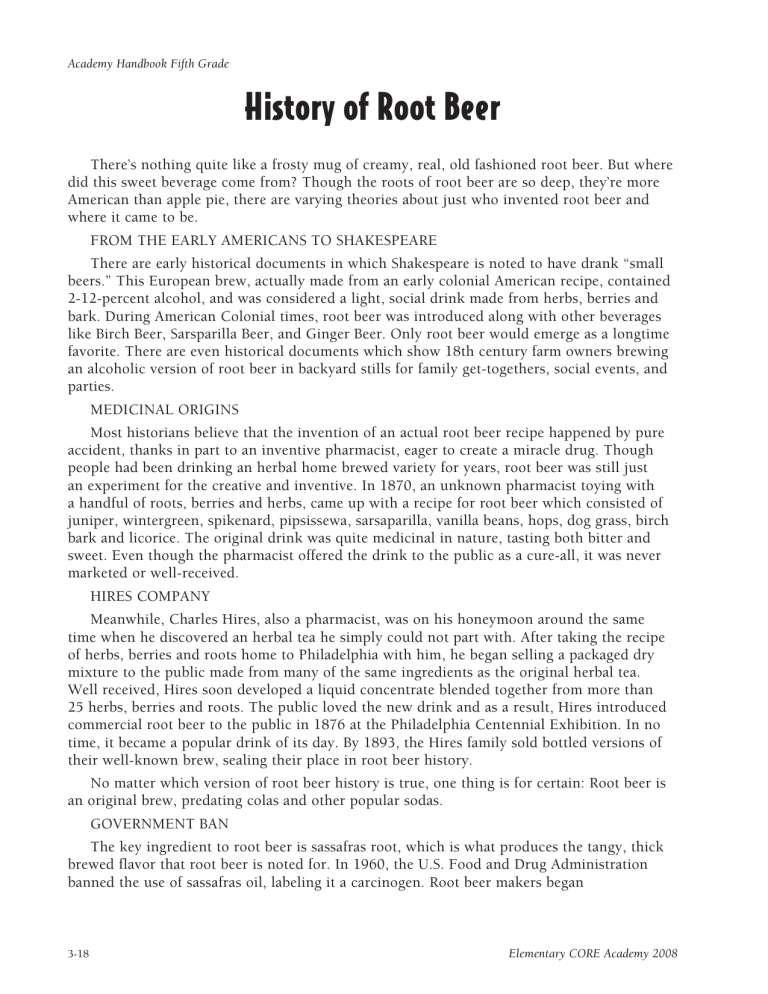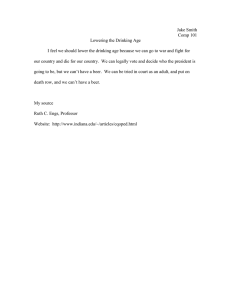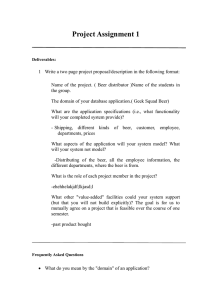
Academy Handbook Fifth Grade History of Root Beer There’s nothing quite like a frosty mug of creamy, real, old fashioned root beer. But where did this sweet beverage come from? Though the roots of root beer are so deep, they’re more American than apple pie, there are varying theories about just who invented root beer and where it came to be. FROM THE EARLY AMERICANS TO SHAKESPEARE There are early historical documents in which Shakespeare is noted to have drank “small beers.” This European brew, actually made from an early colonial American recipe, contained 2-12-percent alcohol, and was considered a light, social drink made from herbs, berries and bark. During American Colonial times, root beer was introduced along with other beverages like Birch Beer, Sarsparilla Beer, and Ginger Beer. Only root beer would emerge as a longtime favorite. There are even historical documents which show 18th century farm owners brewing an alcoholic version of root beer in backyard stills for family get-togethers, social events, and parties. MEDICINAL ORIGINS Most historians believe that the invention of an actual root beer recipe happened by pure accident, thanks in part to an inventive pharmacist, eager to create a miracle drug. Though people had been drinking an herbal home brewed variety for years, root beer was still just an experiment for the creative and inventive. In 1870, an unknown pharmacist toying with a handful of roots, berries and herbs, came up with a recipe for root beer which consisted of juniper, wintergreen, spikenard, pipsissewa, sarsaparilla, vanilla beans, hops, dog grass, birch bark and licorice. The original drink was quite medicinal in nature, tasting both bitter and sweet. Even though the pharmacist offered the drink to the public as a cure-all, it was never marketed or well-received. HIRES COMPANY Meanwhile, Charles Hires, also a pharmacist, was on his honeymoon around the same time when he discovered an herbal tea he simply could not part with. After taking the recipe of herbs, berries and roots home to Philadelphia with him, he began selling a packaged dry mixture to the public made from many of the same ingredients as the original herbal tea. Well received, Hires soon developed a liquid concentrate blended together from more than 25 herbs, berries and roots. The public loved the new drink and as a result, Hires introduced commercial root beer to the public in 1876 at the Philadelphia Centennial Exhibition. In no time, it became a popular drink of its day. By 1893, the Hires family sold bottled versions of their well-known brew, sealing their place in root beer history. No matter which version of root beer history is true, one thing is for certain: Root beer is an original brew, predating colas and other popular sodas. GOVERNMENT BAN The key ingredient to root beer is sassafras root, which is what produces the tangy, thick brewed flavor that root beer is noted for. In 1960, the U.S. Food and Drug Administration banned the use of sassafras oil, labeling it a carcinogen. Root beer makers began 3-18 Elementary CORE Academy 2008 Science Standard I-2&3–Activities experimenting with new and improved recipes, minus the sassafras oil, hoping to find a suitable tasting alternative. Not long after the ban, the root beer industry was saved when inventors discovered that sassafras could be used afterall, if treated first, to remove the oil. WHAT IS IN Root beer? There’s is no true authentic root beer recipe, since there are so many different combinations and brews. Over time, root beer has contained ingredients like allspice, birch bark, coriander seed, ginger and ginger root, hops, burdock root, dandelion root, guaiacum chips, spicewood, wild cherry bark and bitters, wintergreen and wintergreen oil, yellow dock, prickly ash bark and even, molasses. Today, root beer is made from a mixture of flavorings, sweeteners and carbonation. Depending on the brew, bottler and manufacturer, root beer still contains a large number of herbs (burdock root, sarsaparilla root, yellow dock root, ginger root, juniper berries, wild cherry bark, birch bark, etc.), oils (anise, lemon, artificial wintergreen, etc.), sweeteners (sugar, molasses, corn sugar, fructose, asparatame, brown sugar, lactose, malt extract, etc.) and carbonation (yeast, artificial, forced carbonation.) The Root Beer Book: A Celebration of America’s Best-Loved Soft Drink, by Laura E. Quarantiello; ISBN: 0936653787 Utah State Office of Education/Utah State University 3-19

